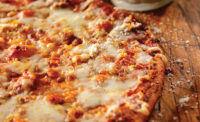The foodservice market can be a profitable one for companies that go beyond convenience to offer healthy ingredients and trendy flavor profiles.
When the recession hit, convenience became a commodity that just wasn’t worth the money for many consumers. As a result, they retreated back into their kitchens to make snacks and baked goods from scratch that they might otherwise grab on-the-run, and cook meals rather than dine out. But now that the economy is improving, consumers are loosening their purse strings and frequenting restaurants again. As a result, the need for convenience foods is stronger than ever.
According to market research firm Canadean, the convenience of prepared foods is increasingly growing in importance in U.S. culture due to the rising number of single-parent homes and the huge increase in working women. Improved economic conditions also create competition between foodservice and prepared and frozen meals, which have been the go-to solutions for consumers during leaner times.
This is a trend reflected in the supply chain. The U.S. Department of Agriculture (USDA) reports that the food marketing system, including foodservice and food retailing, supplied $1.245 trillion worth of food in 2010; of this, $594 billion was supplied by foodservice facilities.
“The state of the foodservice market is ever changing,” explains Tony Schmidt, corporate chef at The Christie Cookie Co., Nashville, Tenn. “With food becoming the spotlight for many Americans, there’s a renewed excitement to the industry as well as an allure of what the industry has to offer. The industry is also expanding with an acceptance of nontraditional foodservice operations, including food trucks, pop-ups, the reinvention of supper clubs and the increased desire for local farmers markets.”
Imitating this overall trend on a more immediate level, foodservice is seeing increased demand this spring after what Andy Alexrod, president of Love and Quiches Gourmet, Freeport, N.Y., called an extremely harsh winter. “The severity of the weather throughout the Northeast, Midwest and Mid-Atlantic caused a hit to our foodservice because people were not venturing out to dinner,” he explains, adding that Love and Quiches’ customers consist of chain and independent restaurants and convenience stores, among others. “In addition, there was a record number of cancelled flights—more than 72,000,” he adds. “An average flight serving food has anywhere from 200 to 300 passengers. Multiply that by 72,000, and that’s a lot of brownies we didn’t sell.”
A dose of health
But according to Schmidt, the number of food bloggers, reviewers and writers is at an all-time high. “Access to information on the trendiest hotspots and food trends is easily accessible to the average consumer,” he explains. “When you couple this with the increased following and development of small craft breweries and distilleries, the industry is in a great place where consumers are willing to try more things and are willing to dine out for those culinary experiences, both traditional and nontraditional in nature.”
The first step outside the conventional box is to foods with healthier nutrient profiles. According to the USDA’s Economic Research Service, restaurant foods have a reputation of being higher in calories and lower in some key nutrients than foods prepared at home. However, its data also shows that restaurants are now offering more healthful choices for nutrition-conscious consumers who are demanding higher quality. Furthermore, eating out, which has long been associated with eating more lettuce and potatoes and less fruits and vegetables, such as grapes, apples and citrus, is getting a makeover of its own—even fast food chains have added vegetable salads and fruit-based items to their menus, the USDA reports.
The Christie Cookie Co., for instance, is offering preservative-free cookies and brownies in a variety of formats: Cookies are available as frozen dough pucks; in pre-baked bulk; and individually wrapped. Brownies are offered in dough and fully baked versions. Soon, the company will launch a muffin batter, formulated without hydrogenated oils or artificial colors or flavors.
“Consumers are more aware of what they are putting into their bodies and more cautious about additives than ever,” Schmidt explains. “This has led to a larger acceptance of paleo, gluten-free, and the consensus that it is acceptable to be vegan or vegetarian, and that these segments of the business need an increased focus to ensure these consumers have an equal experience.”
Axelrod agrees that customers seek “homemade goodness and real food,” which for Love and Quiches, means preservative-free, but are also attaining that “made at home” feel lost in translation when products are made en masse on a production line. The company offers premium quality quiche and authentic New York desserts like cheesecake, brownies and other specialty items.
Eating adventures
Foodie culture has also given rise to a demand for more adventurous flavors. The Christie Cookie Co. is appealing to the popularity of nontraditional flavor profiles by offering sweet-and-salty and sweet-and-spicy options. For example, one new cookie features candy peanuts, salty pretzels and dark chocolate. Along similar lines, Love and Quiches offers a salted caramel brownie and Greek yogurt cheesecake to appeal to today’s trends.
Gagne Foods, Bath, Me., is also seeing an increased demand for products made with nongenetically modified organisms (GMOs) and gluten-free ingredients, says Dennis Lucas, the company’s self-proclaimed “ninja biscuit monger,” but is also appealing to daring palates with two new biscuit offerings. The first is a corn jalapeno variety. “Think moist, not crumbly, corn bread that kicks you in the mouth on the way down,” he says. The other is cranberry/blood orange, which is at home with breakfast, afternoon tea or a bedtime snack. These raw biscuits and pastries go from freezer to oven.
“Consumers are becoming more educated and adventurous,” agrees Rick Kirkpatrick, vice president of sales and marketing at Sweet Street Desserts, Reading, Pa., adding that the company also fields many requests for additive-free products. “This affords us the opportunity to evolve our product line of innovative desserts by taking risks and incorporating trendy ingredients such as Meyer lemons, goat cheese Greek thyme honey or Venezuelan chocolate.”
To that end, Sweet Street Desserts offers more than 400 gourmet desserts from cakes and brulée cheesecakes to macaroons, dessert bars and loaves, scones, cupcakes, parfaits and cookies. Customers include college campuses, hotels, healthcare facilities, sports arenas, convenience stores, airlines and more.
“Consumers have more sophisticated palates and demand more intensely flavored and texturally complex offerings,” Kirkpatrick concludes. “They also aspire to eat more naturally. Operators are responding by looking for pre-portioned, handcrafted desserts with intense flavors and multiple textures that are also additive-free.”
To-do list
There are a number of considerations to keep in mind before making the leap into the foodservice arena, according to Schmidt. “If a company was to enter this space now, it would need to be very aware of any government regulation, both current and future, to ensure it does not develop and launch a product that may need to be reformulated in the near future,” he says.
In addition, equipment may need some upgrading to accommodate larger volumes, should a customer come along, needing quick turnaround on a large order to secure business. Schmidt recommends having a solid, researched plan in place to ensure such customers aren’t lost due to an untimely answer or production schedule.
It’s also critical to be aware of all packaging and labeling requirements, Schmidt continues. “Have packaging that’s eye-catching and reasonably priced to the cost of goods,” he explains. “This is an important aspect because it’s often the best way the operators see your brand. If your carton is brown with a generic label, brand recognition opportunity could be lost.”
For the “hyper-visual” millennials, brand recognition is everything. According to Kirkpatrick, the market share represented by millennial sales will grow substantially over the next five years. “Targeting this growing consumer market will rely heavily on investments in technology, increased personalization of information and promotional messaging, and interactive, real-time communication with consumers,” he adds.
But with real-time communication comes real-time feedback and criticism, and bakers and snack manufacturers need to be ready to make changes to appeal to demand—sometimes on short notice, which goes back to Schmidt’s earlier comment.
“By listening to your consumer and keeping products fresh, with pure ingredients, there is an opportunity to rise above the competition,” says Kirkpatrick. But this can also mean lightning quick turnaround and having plenty of flexibility in a rapidly changing market. “It takes a huge commitment and determination to produce high-quality, complex desserts at the volume we do, while responding to the need for fast profitable turnaround. It also takes organizational excellence to ensure that at the end of the month, it comes together on the bottom line.”










